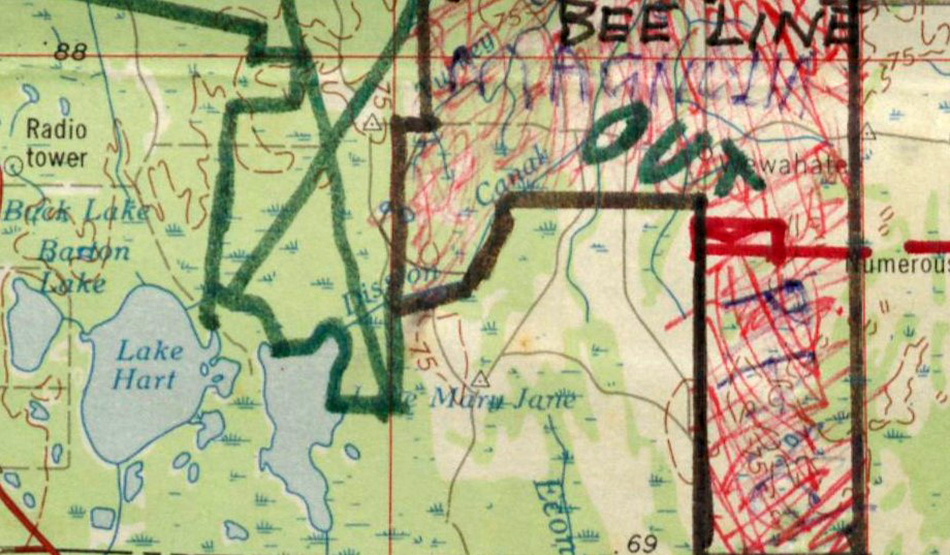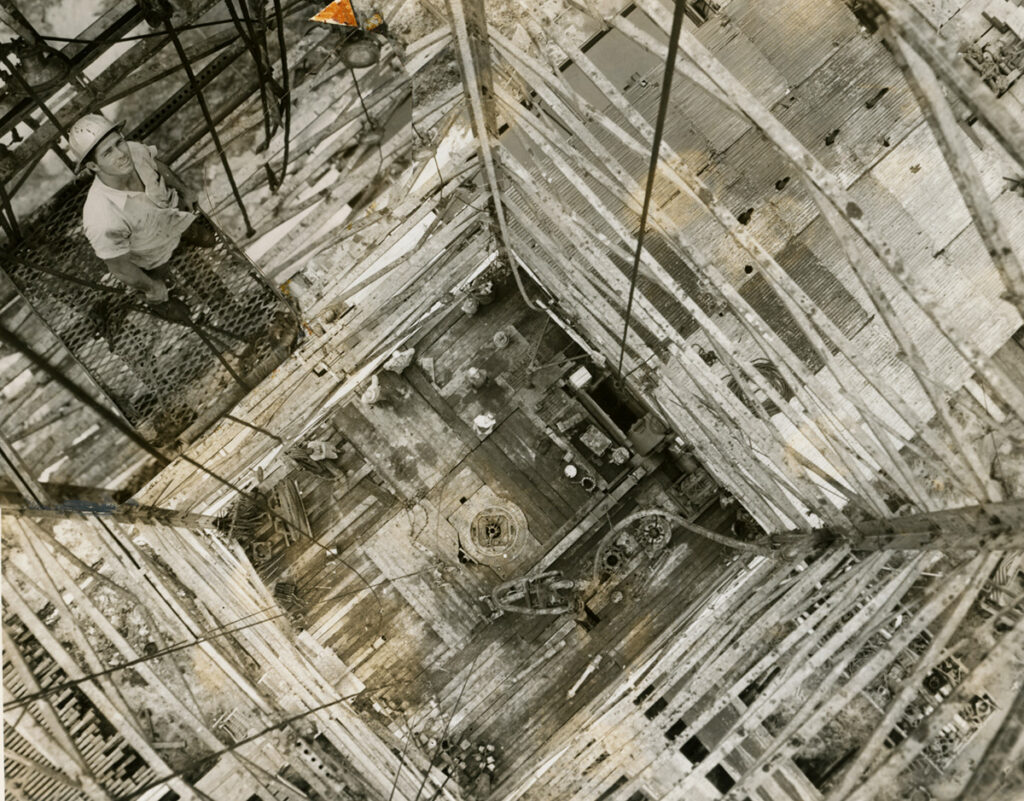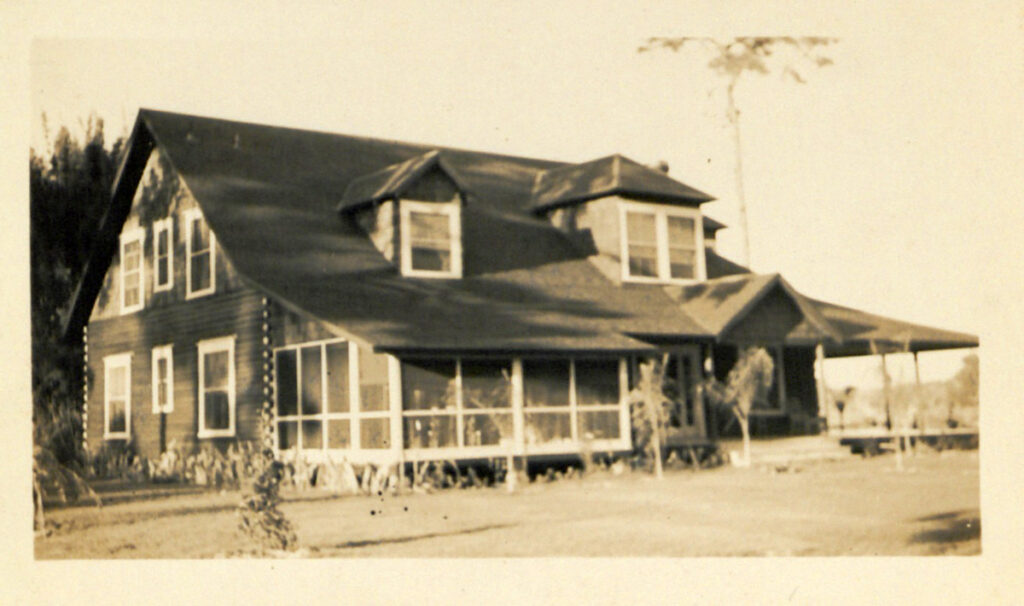By Kelly D’Ambrosio
Land changes hands and names as the years pass, extending its story with each transaction. In the case of a lost Central Florida community named Wewahotee – now often spelled Wewahootee – an expansive story has become muddled by time and land ownership.
Even its exact location is difficult to uncover. Several sources simply use landmarks or vague cardinal directions. In historical sources, it is common to see Wewahotee described as being any of the following: south of Bithlo, west of the St. Johns River, in eastern or southeastern Orange County, and up to 25 miles from Orlando. On maps, it is often located near the Econlockhatchee, Green Branch, or Turkey Creek rivers in the area below the Martin Andersen Beachline Expressway.

Map of Magnolia Ranch land in Wewahotee. The map point for Wewahotee (spelled “Wewahatee”) can be seen beneath the green marker writing. Map courtesy of Orange County Regional History Center. Donated in Memory of George A. Terry, Jr.
A hideout and turpentine camp
Information is scarce prior to the early 1900s, but at least one man did claim to have built his log home in Wewahotee in the 1880s. The name didn’t show up on Orange County maps until 1916, although the Florida East Coast Railway had a Wewahotee stop before that date.
In 1926, Wewahotee became known as the arrest site of Joe Tracy, a surviving member of the Ashley Gang – a group of bank robbers active in Florida in the early 1900s. Tracy was found inside the home of his uncle, Willis Hancock, on the morning of September 4. Florida newspapers continuously retold stories about Tracy and any updates.
There was excitement again in 1932 when a successful Florida naval stores operator, James Russell Moody, decided to lease the rights and build a turpentine camp – along with a cemetery for laborers with no familial ties in the area – on J.B. McCrory’s land in Wewahotee. Within a year, Moody persuaded Orange County officials to supply materials for a school at Wewahotee for Black children, insisting that he would “donate” labor. By the end of 1933, construction was completed, and teachers were appointed for the school.
By the 1940s, Wewahotee had the makings of a town, including a post office, church, and general store. Its nearly 300 residents were mostly Black workers in Moody’s turpentine camp. Turpentine harvesting was physically demanding, and camp operators were known to abuse and overwork their laborers.

Photo of wildcat oil derrick in Wewahotee, the first oil derrick in Orange County. Photo taken by Charles Foley of the Orlando Sentinel in 1955. Photo courtesy of the Orlando Sentinel.
Ranching and drilling for oil
In 1941, J.B. McCrory sold 57,000 acres of land, including his ranch in Wewahotee, to George Terry Sr., whose family moved from New York City to occupy the land for more than three decades. The purchase included the log cabin built in the 1880s, which Terry and his family renovated. Terry’s son, George Terry Jr., named the land Magnolia Ranch after his father’s Magnolia Trading Company. The family mainly used the land for feeder operations and called the community “Hootee.” In later years, some buildings in Wewahotee were brought onto ranch property to use as cottages for cowhands and their families, including a Florida East Coast Railroad equipment shed.
Two years after purchasing the land, the Terrys signed an oil lease with Superior Oil Co., allowing extraction of oil on many of the family’s acres. These leasing rights were utilized in 1955, a year after Magnolia Ranch sold 14,000 acres of its land to the Wewahotee Ranch Company. The land that was sold still held oil leases from the previous decade, and, in July 1955, the first oil dig began in Orange County. A wildcat well was constructed on Wewahotee Ranch property and was named the George Terry Well No. 1. After two months, the drill hit granite at 6,560 feet, and the project was called off. The well was torn down, and the hole was plugged up. Warren Petroleum Corporation, the holders of the oil lease (and of 54,000 acres of Orange County oil leases), became hesitant about drilling anymore in the county.
The following year, Cocoa made an agreement with Orange County to create well fields due to the prevalence of brackish water in its own region. The main water pump was built in Wewahotee and is now called the Wewahootee Water Treatment Plant. It runs along the Cocoa Water Plant Road, which is southeast of the road named after the now-gone community itself: Wewahootee Road, parts of which venture through private property. It no longer belongs to Magnolia Ranch, which was sold in 1979, or Wewahotee Ranch, which dissolved in 1983. Much of what was Wewahotee became part of the massive Deseret Ranch, which spreads through three counties (Brevard, Orange, and Osceola).
By the late 1960s, Wewahotee was rarely ever named as a body of land and never a town. It had been a settlement, labor camp, witness to events newspapers were eager to print, site of Orange County’s first oil-drilling effort, and home to ranchers. It’s now a piece of one of Florida’s largest ranches. Wewahotee was and remains a part of Orange County’s history that can be easily lost and forgotten if the stories about its past are not collected or told.

Home of the Terry family on Magnolia Ranch in Wewahotee. Photo courtesy of the Orange County Regional History Center. Donated in Memory of George A. Terry, Jr.

